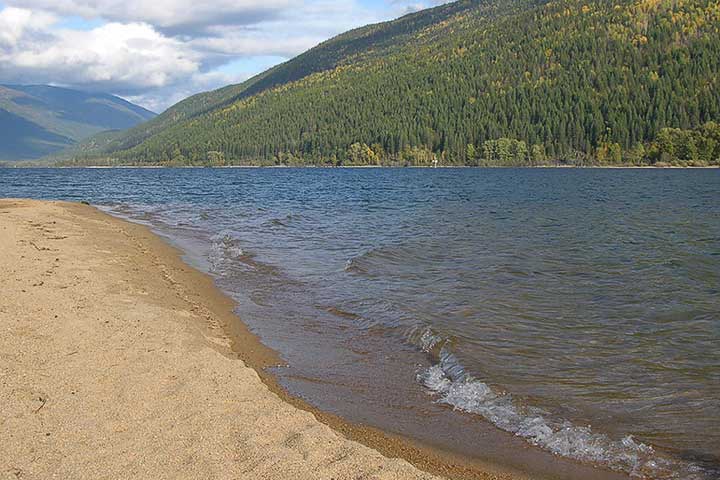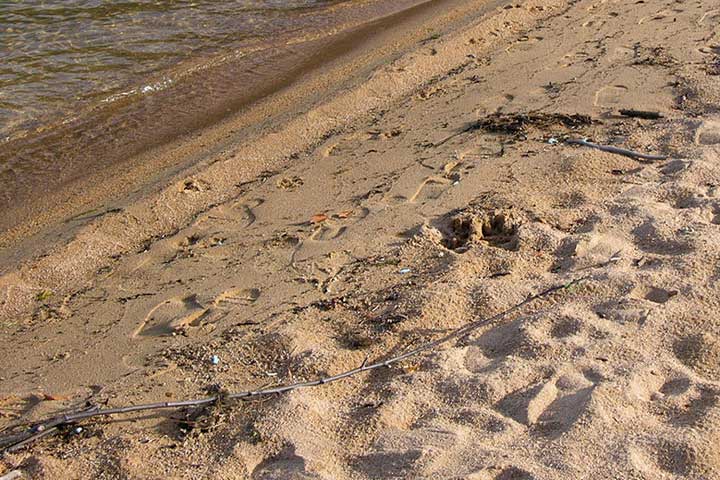Wet sand
Wet sand is a curious substance. If you had never experienced it, and had to guess its properties from a knowledge of its components, you would probably be wrong. It would be reasonable to assume that the properties of wet sand would be intermediate between those of sand and water. But, the sand along the water’s edge behaves differently from either the beach to its one side or the lake to its other. Some of this is obvious from a distance—it is surprisingly dark—some must be experienced directly—it is remarkably firm and cohesive. Indeed, every child knows that a sand castle requires wet sand.
Only familiarity has caused wet sand to pass without note; the accustomed has dulled awe.
The look of wet sand
Dry (fine, yellow) sand reflects light well (it appears bright), water transmits light well (you can see through it); neither absorbs much light. Yet, the mixture appears dark: it absorbs more light than either of its components do separately. This is odd; why is wet sand so dark?
Now, even dry sand absorbs some light; after all, it isn’t brilliantly white. And herein lies the clue to the appearance of wet sand. Somehow, the water is able to increase the amount of light the sand does absorb.
When light falls on a beach, it is reflected from grain to grain rather like a marble bouncing around in a pinball machine. With each bounce in the pinball machine, a little momentum is lost; with each interaction between the a beam of light and sand, a little light is absorbed. So, the appearance of the sand depends on how many sand grains the light interacts with before it happens to bounce back out. Few interactions, little light absorption and the sand appears bright; many interactions, much light absorption and the sand appears dark. The presence of water between the grains increases the number of sand grains the light encounters before it (well, some of it) leaves.
The water changes the average angle at which the light is deviated when it encounters a grain of sand, because water and sand have nearly the same refractive index. If you walked straight into a forest and every time you bumped into a tree, you turned at right angles and headed off in a new direction, then it would not take many tree bumpings before you were likely to be heading back out of the forest (with a few bruises). But, if each time you only changed direction by a few degrees, you would travel deep into the forest and encounter many many trees before emerging (with many bruises).
And this is what water has done. By reducing the average angle at which the light bends at each sand grain, it has caused the light to burrow deeper into the beach, encounter more sand grains, and suffer more absorption before emerging. Although the water didn’t absorb the light, it did cause the sand to absorb more: wet sand looks dark.
The feel of wet sand
Wet sand is firm under one’s feet; dry sand yields. The difference in walking ease is so great, especially when the sand is fine, that most beach walkers saunter along the water’s edge rather than higher on the shore. Further, wet sand is the construction material of choice when children build sandcastles; dry sand lacks the cohesion and forms avalanches rather than walls, and obviously water by itself doesn’t work.
The firmness of wet sand is somewhat unexpected: both water and dry sand yield under foot. Yet, their mixture has remarkably different properties. Once again, this is odd; why is wet sand so firm?
Water is a fluid. Dry sand behaves in somewhat the same way: it can be poured from a container, the various grains sliding past one another. But, add a bit of water to sand and something strange happens. The water acts as a glue to hold the sand grains together. The same forces which enable water to wet other materials (the hydrogen bond), enables it to adhere to sand (which is largely quartz). Mind you, the adhesion between water and the sand is not very great, so the larger the surface area of contact, the greater the effect.
This is why the differences between dry sand and wet sand are so much greater if the sand grains are very small and why similarly fine sand makes the best sandcastles. It may seem counter intuitive for a fine sand to have a greater total surface area than course sand, but it is true. If a sand grain is divided in two, the combined surface area increases. The finer the sand, the greater the total surface of all the grains, and so the greater the bonding when water is added.
 Wet sand is dark One of the real curiosities of a beach is how light-coloured sand appears darker when mixed with water. It seems to defy logic: a light and a clear make a dark! How?
Wet sand is dark One of the real curiosities of a beach is how light-coloured sand appears darker when mixed with water. It seems to defy logic: a light and a clear make a dark! How?
When light enters the sand, it is reflected from grain to grain before eventually escaping. Upon each reflection, some light is absorbed, so brightness at the eye depends upon the average number of grains with which the beam interacts before exiting: few interactions, bright; more interactions, darker. Water increases the average number of interactions. As water is optically (refractive index) similar to sand, each reflection is at a gentler angle and so light burrows deeper into the sand, interacts with more grains, and suffers more absorption.
 Wet sand is firm Footprints in dry sand are little craters formed as the sand flows out from around the foot. Footprints in wet sand are shallow indentations. The wet sand provides much better support for walking. Water adheres to the many small sand grains and holds them together.
Wet sand is firm Footprints in dry sand are little craters formed as the sand flows out from around the foot. Footprints in wet sand are shallow indentations. The wet sand provides much better support for walking. Water adheres to the many small sand grains and holds them together.
![]()